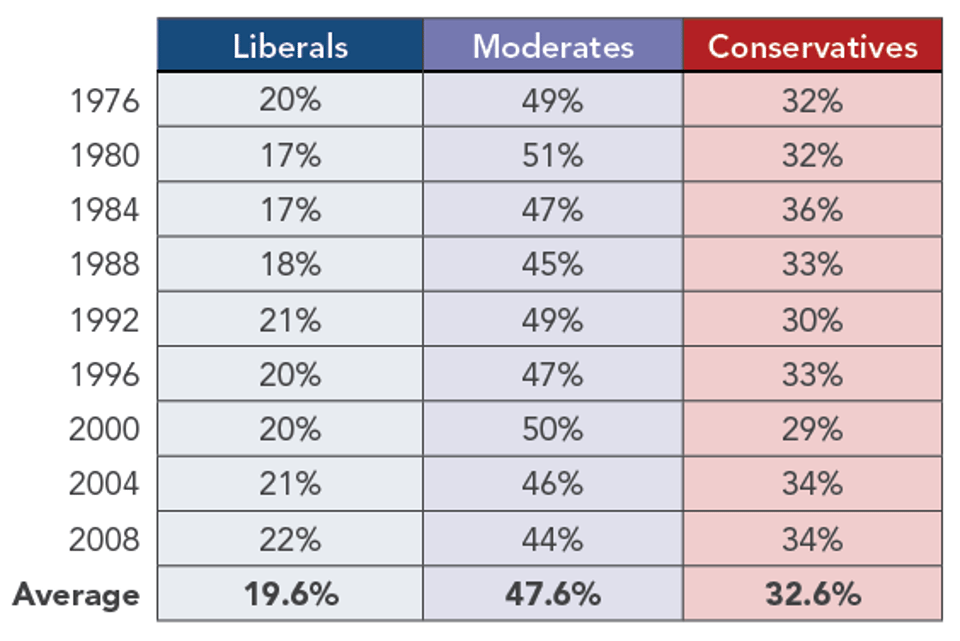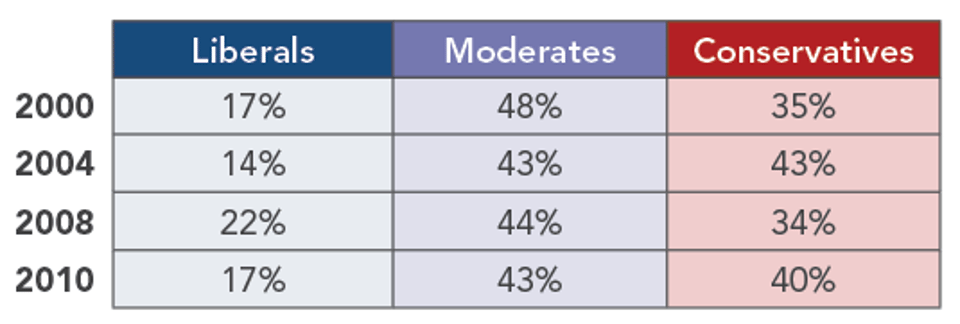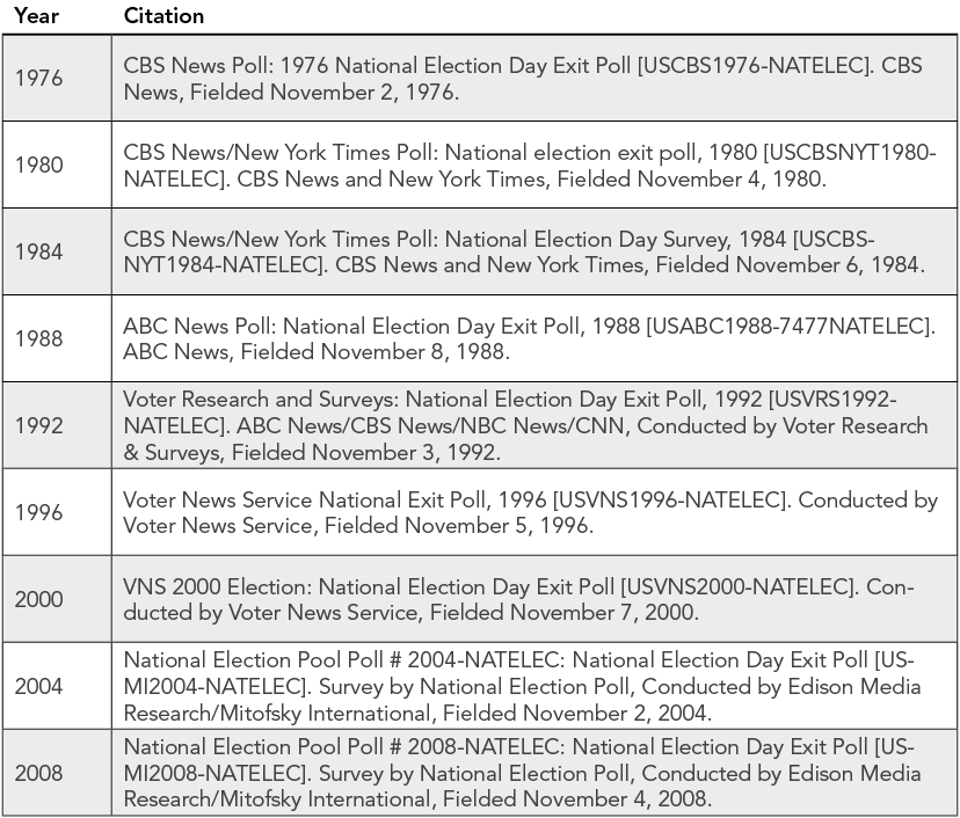Report Published May 21, 2012 · Updated May 21, 2012 · 14 minute read
Senate Battlegrounds: Democrats Need a Moderate Majority
Michelle Diggles, Ph.D. & Lanae Erickson
This report analyzes the toss-up U.S. Senate races and finds that moderates will determine control in 2012. Crucially for Democrats, they must garner a majority of moderates in 9 of the 10 toss-ups to win, and in 7 of those, the bar is even higher—Democrats must clear 60% to win. In this report, we:
- Show that moderates are crucial to victory in Senate battleground states; and,
- Provide detailed state-by-state analysis of the role moderates will play in the toss-up Senate races.
The Overview
Moderates are crucial to victory in battleground Senate states.
They say sixty is the new fifty. But 50+1 still constitutes majority control of the U.S. Senate. This year 33 seats are up for election—21 Democratic, 2 Independent, and 10 Republican.
Based on current projections, 8 seats are expected to remain Democratic—California, Delaware, Maryland, Minnesota, New Jersey, New York, Rhode Island, and Vermont—and 5 Republican—Mississippi, Tennessee, Texas, Utah, and Wyoming. Of the remaining 20 Senate races, 7 lean or are likely Democratic—Connecticut, Florida, Michigan, Ohio, Pennsylvania, Washington, and West Virginia—and 2 currently lean Republican—Arizona and Nebraska. One, Maine, is likely to be won by former Governor Angus King, an Independent widely expected to caucus with Democrats. Thus, Democrats must win 5 and Republicans 7 of the remaining 10 toss-up races to claim the Senate gavel.
Of the Senate toss-ups where there is no major third party candidate,* the Democratic candidate has to win a majority of moderates in 9 of the 10 races to be victorious in November. And in 7 of those, the bar is even higher—the Democratic candidate would need at least 60% of the moderate vote to win.**
Due to Maine’s unique election, it is not included in this estimate.
* See Appendix B for all of the data sources in this report.
Based on exit polls from the past two presidential elections and the past two cycles for these Senate seats—which were up for election last in 2006 and before that in 2000—we calculated the approximate percent of moderates each candidate would need to win in November. Assuming that the Democratic candidate wins 85% of the liberal vote (and 15% of the conservative vote) and the Republican candidate garners 85% of the conservative vote (and 15% of the liberal vote), we calculated that on average in these ten states the Democratic candidate would need 59% of moderates and the Republican candidate 42%.
Estimated Percent of Moderates Senate Candidates Need to Win in 2012

Looking at the 2006 exit polls, when these Senate seats were last in cycle, moderates were the plurality of voters. In 4 states—Hawaii, Massachusetts, North Dakota, and Wisconsin—moderates comprised 50% or more of the 2006 electorate. On average in these states, 47.3% of the electorate was moderate in 2006.
In the states where 2006 exit polls are available,* Senators, on average, won with 66.2% of the moderate vote in 2006. Only former Sen. Ensign (R-NV) won in 2006 with less than half of the moderate vote. All but one of the Democratic Senators received at least half of the moderate vote in 2006 to win, with 7 Democrats receiving 60% or more.
Indiana is not included in this analysis because they did not have an exit poll for the 2006 election.
Senate Toss-Ups and Moderate Voters in 2006*

There was no statewide exit poll in Indiana in 2006. Figures are for Sen. Kennedy’s re-election in 2006. No exit polls were available for the special election in Massachusetts in 2010. Figures are for Sen. Ensign’s re-election in 2006. Sen. Heller was appointed to the position after Sen. Ensign resigned.
Although midterm elections tend to result in a slightly different composition of the electorate, moderates have played a major role in presidential election years as well. Indeed, moderates have constituted the largest segment of the electorate—a plurality of voters, outnumbering liberals and conservatives—in every presidential election of the modern era. During the past 9 presidential elections—since 1976—moderates have composed an average 48% of the electorate.
National Electorate in Presidential Elections

Clearly, the influence of moderate voters cannot be overstated, especially for Democratic candidates, who start with a smaller liberal base. For Democrats in the Senate battlegrounds, winning a moderate majority is necessary for victory, and for many, a mere majority isn’t sufficient to carry the day.
State-by-State Analysis
Hawaii: Blue Hawaii?
Democratic Senator Daniel Akaka—appointed to the U.S. Senate in 1990 and subsequently re-elected to serve 3 full terms—announced his retirement in 2011, leaving the seat open for November. The Republican nominee will likely be former Hawaii Governor Linda Lingle. There are 2 Democratic candidates vying for the nomination—Representative Mazie Hirono (HI-1) and former Representative Ed Case. The primaries will be held on August 11, 2012. Most current polling has both Rep. Hirono and Case leading Lingle.
Moderates composed a majority of the Hawaiian electorate in 2006 and a plurality in 2000—the last 2 cycles for this Senate seat. Sen. Akaka won 64% of moderates in 2006 and nearly three-quarters in 2000. However, Sen. Akaka has not had a competitive race since he won the 1990 special election. Over the last 2 Presidential cycles—2008 and 2004—the number of moderates in the Hawaiian electorate has remained stable at 48%. Liberals composed 28% of the state’s electorate in 2008 (29% in 2004) and conservatives 24% in 2008 (23% in 2004).
Hawaii Senate Elections by Ideology*

In 2000, Sen. Akaka (D) defeated John Carroll (R). In 2006, Sen. Akaka defeated Cynthia Thielen (R).
If we assume that the number of moderates is consistently around 48% and liberals and conservatives are roughly split even, then either candidate would need 51% of the moderate vote to win.
Indiana: Hoosiers
Republican Senator Richard Lugar—first elected to the Senate in 1976—was defeated by State Treasurer Richard Mourdock in the primary. The Democratic nominee is Rep. Joe Donnelly (IN-2)—elected in 2006 and subsequently reelected for two more terms.
Sen. Lugar did not have a major party rival in 2006. Thus, there is no exit polling available. But in 2000, Sen. Lugar won 87% of the conservative vote and his Democratic challenger won 56% of the liberal vote. In 2008, President Obama won 88% of liberals and Sen. McCain 78% of conservatives.
Composition of Electorate in Indiana

If the 2012 electorate remains 17% liberal and the average of 40% conservative, then moderates would compose 43% of the electorate. For Rep. Donnelly to win in November, he will need to secure approximately 69% of moderates, while Mourdock only likely needs 32%.
Massachusetts: The Departed
Republican Senator Scott Brown—elected to the Senate in 2010—replaced veteran Sen. Edward Kennedy by defeating challenger Martha Coakley. This November he will face Elizabeth Warren, best known as chair of the committee tasked with overseeing TARP and spearheading the Consumer Financial Protection Bureau. Massachusetts skews more liberal than conservative in most years, with moderates comprising half of the voters in recent elections.*
As an aside, Independents now outnumber both Democrats and Republicans in Massachusetts.
There was no exit poll for Sen. Brown’s election in 2010. Sen. Kennedy won supermajorities of moderates in the past 2 elections; however, he was not seriously contested in either. In 2008, moderates comprised 46% of the electorate and 45% in 2004. In the last 3 presidential elections, liberals have outnumbered conservatives by 11-13 points. If we assume 46% of voters in November will be moderates, and liberals maintain their 10 point advantage, the electorate would be 32% liberal and 22% conservative.
Massachusetts Senate Elections by Ideology*

In 2000, Sen. Kennedy defeated Jack Robinson (Republican) and Carla Howell (Libertarian). Their percentages were added to calculate the total amount won by the “challengers” that year. In 2006, Sen. Kennedy defeated Kenneth Chase.
If Sen. Brown and Warren each secure 85% of the conservatives and liberals (and 15% of the liberals and conservatives), respectively, Sen. Brown would need 58% of moderates and Warren 43% to win in November. It is worth noting that this is the only state among the toss-ups where the Republican nominee needs to garner more of the moderate vote than the Democrat to win.
Missouri: Meet Me in St. Louis
Democratic Senator Claire McCaskill—elected to the Senate in 2006—is up for re-election. Three Republicans are vying for the chance to unseat the one-term Senator—Rep. Todd Akin (MO-2), John Brunner, and former state treasurer Sarah Steelman. Steelman is currently the frontrunner, with Rep. Akin in second. But neither is polling above 50%. In the general match-up, no polls show Sen. McCaskill over 50%, and the horserace between her and either Akin or Steelman is within the margin-of-error.
Missouri Senate Elections by Ideology*

Figures for 2000 reflect the amount won by Sen. Carnahan (D), not Sen. McCaskill. In 2000, Sen. Carnahan defeated John Ashcroft (R). In 2006, Sen. McCaskill defeated Jim Talent (R).
With liberals accounting for only 20% of the electorate in the last 2 Senate cycles, and 19% in the last 2 presidential races (2008 and 2004), securing moderates is Sen. McCaskill’s best chance for reelection. Moderates composed 45% of the electorate in the last 2 presidential cycles, and they are likely to hold that share this time around. If Sen. McCaskill can secure 85% of the liberal vote and 15% of the conservative vote, she would still need 62% of moderates to win (while her challenger would only need 39%). President Obama won 86% of liberals and 61% of moderates in Missouri in 2008.
Montana: Cloudy With A Chance of Meatballs
Democratic Senator Jon Tester—elected to the Senate in 2006—is up for re-election. He defeated three-term incumbent Sen. Conrad Burns (R) in 2006. His likely challenger is Republican Representative Danny Rehberg (MT- at-large), currently running uncontested.
Montana Senate Elections by Ideology*

The figures for 2000 reflect the amount won by Brian Schweitzer, the Democratic challenger to incumbent Sen. Burns, not Sen. Tester.
In the last 2 presidential elections, moderates have comprised 46% of the Montana electorate. Liberals will likely comprise 20% of the electorate (they were 21% in 2008 and 18% in 2004) and conservatives 34% (they were 34% in 2008 and 36% in 2004) in 2012. If we assume Sen. Tester wins 85% of liberals and 15% of conservatives, and Rep. Rehberg wins 85% of conservatives and 15% of liberals, then Sen. Tester would need 61% of moderates—and Rep. Rehberg 40%—to win in November.
Nevada: What Happens in Vegas
Republican Senator Dean Heller—appointed in March 2011 to serve the rest of Sen. Ensign’s term after he resigned—is running for reelection against Democratic candidate Rep. Shelley Berkley. This race is expected to be very close and may come down to a handful of votes.
Nevada Senate Elections by Ideology*

Sen. Ensign resigned from office in 2011 and Sen. Heller was appointed to fill the vacancy. In 2000, Sen. Ensign defeated Edward Bernstein for the open seat. In 2006, Sen. Ensign defeated Jack Carter.
In the last 2 presidential elections, conservatives comprised 34% of the electorate in Nevada, while liberals were 22% in 2008 (18% in 2004) and moderates were 44% in 2008 (47% in 2004). Liberals—whose share of the electorate fell to 19% in 2010—are likely to comprise 20% of the electorate in 2012, and conservatives at least 34%, leaving moderates as 46%. In 2010, Sen. Reid won 83% of the liberal vote and Sharon Angle 77% of the conservative vote. If we assume this year’s candidates win liberals and conservatives with an 85%–15% split, Rep. Berkley would need 61% of moderates and Sen. Heller 40% to win in November.
New Mexico: City Slickers
Five-term Democratic Senator Jeff Bingaman announced his retirement in 2011. While the primary field is crowded on both sides, the likely nominees are Rep. Martin Heinrich (D) and former Rep. Heather Wilson (R). Rep. Heinrich holds Wilson’s former seat, which she vacated in 2008 in an unsuccessful bid for the U.S. Senate. Both candidates hail from the Albuquerque area.
New Mexico Senate Elections by Ideology*

In 2000, Sen. Bingaman defeated Bill Redmond. In 2006, Sen. Bingaman defeated Allen McCulloch.
In the last 3 presidential elections, liberals have comprised 22% of New Mexico’s electorate. Conservatives peaked at 36% in 2004—likely the high water mark—and fell to 34% in 2008. If we assume that liberals comprise 22% and conservatives 34% of the voters in November, then moderates would maintain their share of the electorate at 44% this fall. If Rep. Heinrich can secure 85% of the liberal vote and 15% of the conservative vote, he will need 60% of the moderates to win. However, if Rep. Wilson can secure 85% of the conservative vote and 15% of the liberal vote, she will only need 41% of moderates to secure victory.
North Dakota: Plains, Trains, and Automobiles
Democratic Senator Kent Conrad—first elected in 1986—is retiring. Rep. Rick Berg is the likely Republican nominee. Former attorney general Heidi Heitkamp is the likely Democratic nominee. Both candidates are considered strong by their respective parties. Heitkamp’s appeal is to Independents, with some polls giving her a 10+ point lead among that group. Rep. Berg unseated nine-term Democratic Rep. Earl Pomeroy in the midterms.
North Dakota Senate Elections by Ideology*

In 2000, Sen. Conrad defeated Duane Sand. In 2006, Sen. Conrad defeated Dwight Grotberg.
During the last 2 presidential elections, the share of liberals in the state’s electorate ranged from 13% (2004) to 16% (2008) and conservatives from 33% (2004) to 36% (2008). It is unlikely that conservatives will fall as a percentage of the North Dakota electorate this year. The most likely scenario is for the 2008 electorate to remain steady, at 16% liberal, 48% moderate, and 36% conservative. If the Democratic and Republican candidates can win 85% of liberals and conservatives, respectively—and 15% of conservatives for the Democrat and 15% of liberals for the Republican—then Heitkamp would need 65% of moderates and Rep. Berg 36% to win in November.
Virginia: The Usual Suspects
With Democratic Senator Jim Webb retiring after one-term, the Virginia Senate race—pitting 2 former Governors against each other—is likely to be one of the costliest this year. Republican former Senator and Governor George Allen is running for the seat he lost in 2006. Democratic former Governor and DNC Chair Tim Kaine will be his opponent.
Virginia Senate Elections by Ideology*

In 2000, Sen. Allen defeated incumbent Democratic Sen. Chuck Robb. In 2006, Sen. Webb defeated Sen. Allen. The data for 2000 is for Sen. Robb (D) and for 2006 is Sen. Webb (D).
The Virginia electorate has been changing in the past few presidential cycles, as the conservative share increased to 38% in 2004 before falling to 33% in 2008. This fall’s electorate is likely to be approximately 21% liberal, 46% moderate, and 33% conservative. Virginia will be a highly competitive race, with Allen and Kaine likely securing 85% (or more) of the conservative and liberal vote, respectively. In that scenario, Allen would need 41% and Kaine 60% of the moderate vote to win in November.
Wisconsin: Fight Club
Democratic Senator Herb Kohl—elected in 1988 and subsequently reelected for 4 more terms—is retiring after his term ends. One Democrat—Rep. Tammy Baldwin (WI-2)—is running for the open seat. Four Republicans—including frontrunners former Gov. Tommy Thompson and former Rep. Mark Neumann—are vying for the nomination. Thompson was a popular Governor but has been attacked in the primary as too moderate. Neumann is the Tea Party choice.
Wisconsin Senate Elections by Ideology*

In 2000, Sen. Kohl defeated Gill. In 2006, Sen. Kohl defeated Lorge.
While moderates were a majority of the electorate in 2000, they fell to 47% in the most recent presidential election. At the same time, liberals increased their share to 23% in 2008, with conservatives at 31%. The electorate is likely to remain unchanged in 2012, partially because Wisconsin’s politics have become very polarized since Gov. Scott Walker came to power in 2011.
If we assume Rep. Baldwin will win 85% of the liberal vote and 15% of the conservative, and the Republican nominee will flip those percentages, then she would need at least 56% of moderates and the Republican candidate 44% to win in November.
Conclusion
In the key Senate races which will determine control of that body in the next Congress, moderate voters will be the kingmakers—especially for Democrats. To be victorious, Democratic Senate candidates in all but one of these states must win a moderate majority in November—and in most, they must clear 60% of the moderate vote. Now more than ever, Democrats must keep their eye on the center of the electorate to keep the majority in the Senate
Appendix A
U.S. Senate Seats Up for Election in 2012

Appendix B
All of the exit poll data used in this report (except where indicated in the table below) is located at the Roper Center for Public Opinion Research at the University of Connecticut.
The data on national election polls from 1978-2010 can be accessed at: http://www.ropercenter.uconn.edu/elections/common/exitpolls.html#.T7QhrVL5DQ.
National Exit Poll Data Sources

The data on state election polls from 1978-2010 can be accessed at: http://www.ropercenter.uconn.edu/elections/common/state_exitpolls.html#.T7QgLlL5DQg.
State Exit Poll Data Sources


